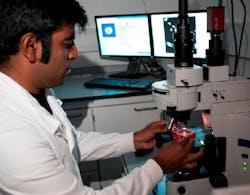Ptychography method uses phase information for high-contrast, label-free imaging
Sheffield, England--Researchers at the University of York (York, England) have published a paper in Nature detailing their work on patented ptychography imaging technology from Phasefocus. The paper, entitled "Ptychography—a label free, high-contrast imaging technique for live cells using quantitative phase information" is an open access paper from University of York lead authors Joanne Marrison and Peter O'Toole, the latter being head of the Imaging and Cytometry Laboratory.
Quoting from their summary, the authors describe the motivation for this work: "Cell imaging often relies on synthetic or genetic fluorescent labels, to provide contrast which can be far from ideal for imaging cells in their in vivo state. We report on the biological application of a label-free, high contrast microscopy technique known as ptychography, in which the image producing step is transferred from the microscope lens to a high-speed phase retrieval algorithm. We demonstrate that this technology is appropriate for label-free imaging of adherent cells and is particularly suitable for reporting cellular changes such as mitosis, apoptosis and cell differentiation. The high contrast, artefact-free, focus-free information rich images allow dividing cells to be distinguished from non-dividing cells by a greater than two-fold increase in cell contrast, and we demonstrate this technique is suitable for downstream automated cell segmentation and analysis."
The authors conclude that this has tremendous potential. "The system generates high quality images using inexpensive, low magnification objective lenses without the need for the addition of cytotoxic labels, a technical advance which has far reaching implications for cancer research and drug discovery. Not only are the images high in contrast, but they are also artefact free making them ideal for downstream segmentation and image analysis. The ability to focus post-acquisition allows all cells, even in an uneven field, to be brought into focus and not omitted from subsequent analysis. Time is also saved pre-acquisition as cells can be imaged directly in tissue culture plastic ware.”
The researchers continue, “We have shown here that this technique is suitable for cell cycle analysis, identifying cells entering and exiting mitosis and dissecting the phases of mitosis. Ptychography would be ideal for in-incubator assays, reporting over prolonged periods of time on cell proliferation and cell cycle stages in situ. These are only initial studies but clearly demonstrate the potential of label-free ptychographic imaging. With the technology rapidly developing, faster acquisition times, smart auto-focus, increased contrast and ease of use, and the ability to add the facility to other systems e.g. confocal microscopes, make the future opportunities diverse and very attractive."
Dr O'Toole describes ptychography as "one of the most important breakthroughs in imaging. It addresses many of the fundamental problems inherent in current microscopy techniques. Put simply, what you get is far more than what you see. Artefacts of sample preparation which may arise from labelling or use of markers are negated. I have been most impressed by Phasefocus and their ability to quickly respond to feedback and then to develop products to meet the needs of the user. I wonder where the technology will go? I feel the journey is just beginning and microscopy is nowhere near the end of the road with regards to development."
Phasefocus is a venture capital-backed spin-out company from the University of Sheffield founded in 2006 and focusing on development of its Phasefocus Virtual Lens [trademarked] technology. In February 2013, the Company announced that it had entered into a Licensing Agreement with Gatan, manufacturer of instrumentation and software used to enhance and extend the operation and performance of electron microscopes. A prototype "add-on" product for existing electron microscopes has already demonstrated an improvement in resolution of a factor of five over that available using the host instrument's conventional electron optics. Its products also include an optical microscope used for label-free time-lapse imaging of biological cells, and an Ophthalmic Lens Profiler that can measure soft contact lenses with high resolution and accuracy.
SOURCE: Phasefocus; http://www.phasefocus.com

Gail Overton | Senior Editor (2004-2020)
Gail has more than 30 years of engineering, marketing, product management, and editorial experience in the photonics and optical communications industry. Before joining the staff at Laser Focus World in 2004, she held many product management and product marketing roles in the fiber-optics industry, most notably at Hughes (El Segundo, CA), GTE Labs (Waltham, MA), Corning (Corning, NY), Photon Kinetics (Beaverton, OR), and Newport Corporation (Irvine, CA). During her marketing career, Gail published articles in WDM Solutions and Sensors magazine and traveled internationally to conduct product and sales training. Gail received her BS degree in physics, with an emphasis in optics, from San Diego State University in San Diego, CA in May 1986.
